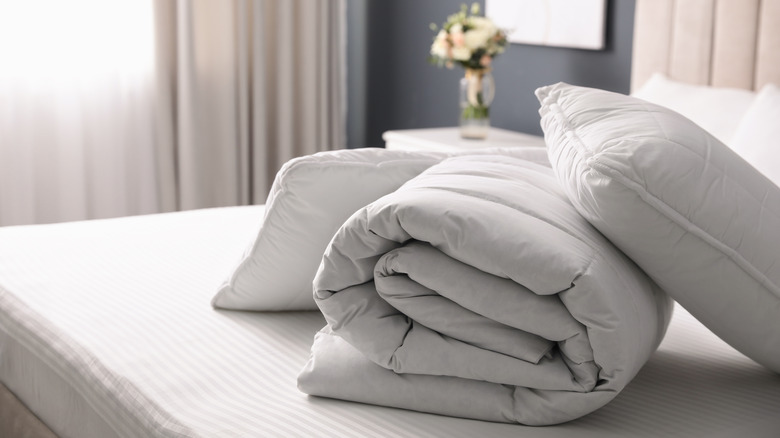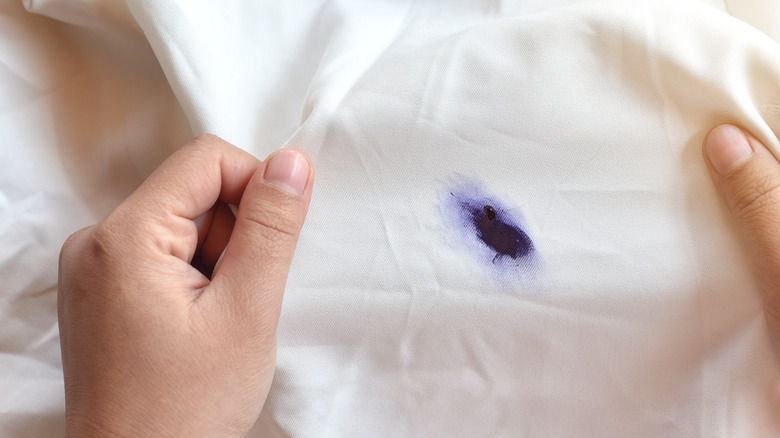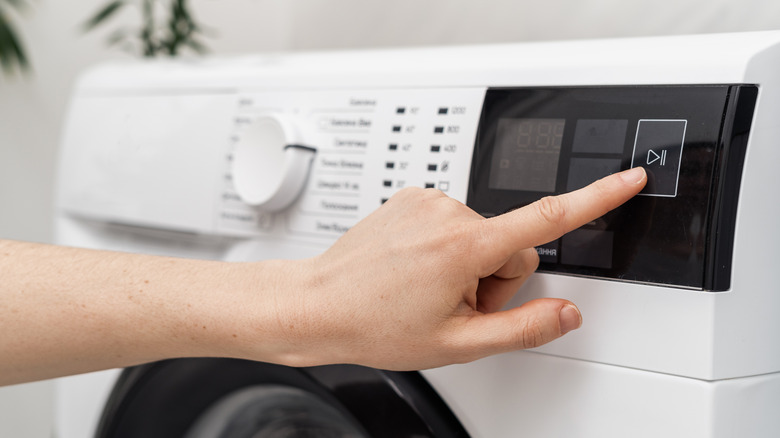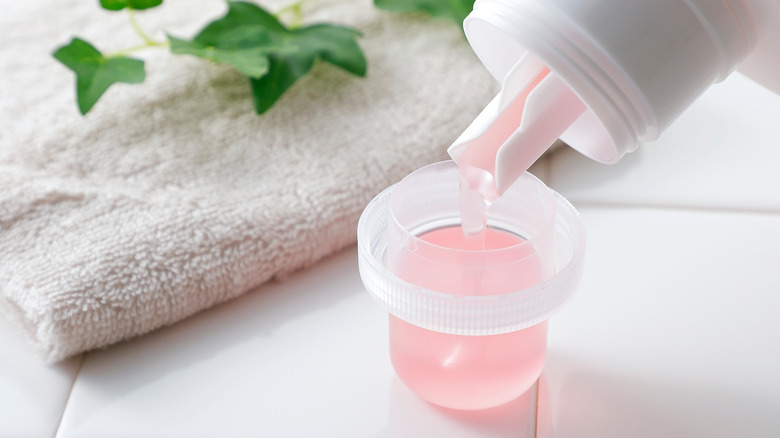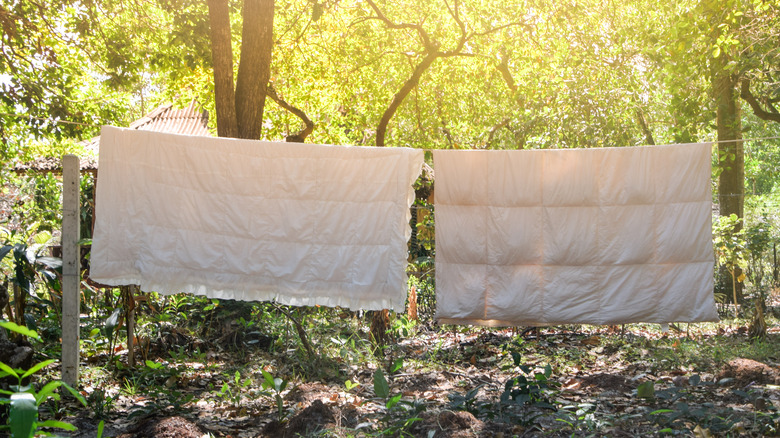How To Successfully Clean Your Duvet
While you clean bedding items like sheets, pillow cases, and duvet covers on a regular basis, have you ever thought of just how frequently (or infrequently) you're actually cleaning your duvet? According to Good Housekeeping, the average person releases about 200 mL of sweat every night, and if you're the type of sleep with your duvet wrapped around you like a cozy burrito, well, there's only place all that moisture is going — right into your duvet. Hence, the need to clean them.
Now, you don't have to get crazy and deep clean your actual duvet weekly. However, as Martha Stewart recommends, you should consider laundering them about once or twice a year. Many advise getting them professionally laundered, but if that expense seems too much (or you simply don't want to lug your duvet to the dry cleaner), it is possible to clean your duvet at home as well. To that end, here are 15 tips and tricks to consider in order to get the best results — and a fresh, clean duvet to curl up under every night.
1. Start by reading the label
This may seem like an insanely simple step, but it's important — before you get started, find the label on your duvet and give it a quick read, as Clean Mama recommends. Even if it says dry clean only and you decide to risk it at home, the label might be able to give you some helpful guidance as to the water temperature, the drying temperature, and other requirements unique to your particular duvet. The more information you have, the better.
2. Remove the cover, if you use one
Most people, especially with down-filled duvets, use a cover to encase and protect the duvet, just like a pillowcase does with your pillow. While it may be tempting to toss the whole thing in (after all, you need to wash the cover as well), when it comes to thoroughly cleaning your duvet, you need to remove it the cover, as per Clean Mama's advice. This will allow all those suds to really target the grime that needs battling in your duvet, rather than just the surface dirt on the cover.
3. Deal with any stains first
Washing a duvet is a little more complicated than tossing in a batch of socks and t-shirts, so you want to give yourself all the help you can get — and that includes treating any stains first, before the duvet hits the washing machine, as per Casper. Use your favorite stain removal solutions to eliminate any stains you spot once the cover is off, and handle those problem areas before you start cleaning the entire thing.
4. Ensure no repairs need to be made
The last thing you want is feathers flying around your dryer and laundry room because there was a tiny hole in the corner that you didn't know about. To avoid any disasters, as Architectural Digest recommends, examine your duvet thoroughly to ensure there are no rips and tears that were covered up by the duvet cover. It may take an extra few minutes, but it'll be worth it in the end. If you do happen to catch something, quickly stitch it up and repair it prior to cleaning the duvet.
5. Check the size of your washing machine drum
Whether you have a twin size or king size duvet, the fact is, they're pretty bulky — so you may want to consider the size of your washing machine drum to ensure it can actually accommodate your duvet, as Real Homes suggests. A general rule of thumb? If your washing machine has a drum capacity of about 7 kilograms/15 pounds, you should be okay to wash a double duvet. If you have a super-sized duvet cover and a smaller washing machine, you might consider using a large-size washing machine at a laundromat for this particular chore.
6. Wash your duvet solo
If you happen to have a larger washing machine, you might be tempted to toss in a few other things to cross a few other things off your list. However, as Architectural Digest warns, you really want to make sure to wash the duvet solo. This is because your duvet needs room to move around that drum in order to get squeaky clean, and anything else you toss in the load with it could jeopardize that.
7. Spread out the duvet as much as possible
One of the key tips to cleaning your duvet is to give it as much space as possible so it can to move around in both the washing machine and the dryer. So, as Casper suggests, give your duvet plenty of room and stretch it out. Obviously, this doesn't mean laying it flat — it just means strategically positioning it so that it's not just a compacted ball, but rather layers of ready-to-clean, mobile duvet that can tumble around your washing machine.
8. Grab some tennis balls and a sock
You may have heard this trick before, but it's a simple yet super effective tip: For the best results and cleanest duvet, you want to grab a few socks with tennis balls placed in them and toss them in both the washer and the dryer during the process, as The Spruce and Real Simple both recommend. The tennis balls will bounce around and hit the duvet throughout the cycle, helping to remove any extra grime, to keep the duvet moving, and to prevent the filling from clumping or bunching as it dries.
9. Select the right detergent
Though reading the label might have given you a few clues, make sure to consider what the appropriate detergent would be. As Real Homes explains, for a duvet with a synthetic filling, you can likely use your preferred detergent. Down or feather duvets should be cleaned with a non-biological detergent to prevent any potential damage. Ultimately, as HGTV clarifies, you'll want to go with a relatively gentle, mild detergent to ensure the best results.
10. Select the right cycle
While your washing machine may have a "bedding" cycle, this isn't the time to use that. Instead, as HGTV recommends, you'll want to go for a delicate setting, or "the gentlest cycle possible" on your particular machine. An added bonus — if you have this option on your machine, as Casper suggests, you may want to include an extra spin and rinse cycle in order to really get all that soap and as much moisture as possible out of your bulky duvet.
11. Check to make sure there's no detergent residue
The last thing you want is to finish your duvet-cleaning process and realize that your formerly fluffy down duvet doesn't quite feel right — as The Spruce explains, "residue will cause clumps in your down." So, before you transfer that duvet to the dryer, take a quick peek to see if there are any signs of residue, such as suds, lingering on your duvet — if so, you may need to send it through for another rinse cycle with just water to get everything out.
12. Skip the fabric softener if you have a down duvet
You might be thinking that when it comes to bedding, the softer the better — and while you certainly want to luxuriate in the softness of your pillowcases, duvet cover, and sheets, skip the fabric softener when washing your duvet itself. As Pacific Coast Feather Company states, though fabric softener works on fabrics, when it interacts with down it can actually coat those feathers and make your duvet less of the fluffy sleep-supporting cloud you want it to be.
13. Go low and slow with the dry time
Though you might be tempted to expedite the process and blast your duvet with high heat to dry more quickly, avoid that urge. For best results, just as you wanted a gentle cycle in the washing machine, you want your dryer to be on the lowest setting, as HGTV recommends. And, your duvet-washing day may not be the best day for other errands — while it depends on your dryer and the type of duvet you have, in general, it can take three or more hours to fully dry.
14. Dry and fluff in bursts
Again, while washing a duvet at home isn't impossible, it comes with a few challenges; while you can expect it to take several hours to fully dry, that doesn't mean you can set it and forget it. If you truly want your duvet to end up not just clean but fluffy and like new, as per HGTV, you'll want to dry it in 30-minute bursts. In between increments, take it out and fluff it up, redistribute those tennis balls, and just basically help prevent it from becoming a clumpy mess. It takes extra effort, but it will pay off in the end.
15. Consider finishing on a clothesline
If you're finding that it's taking forever for your duvet to dry, or you simply don't have the patience to monitor it and fluff it every half hour, there's another alternative for those later stages of the drying process. Consider hanging your duvet on a clothesline where the air can circulate and the interior can fully dry. An added perk if you do so outside is that, since typically duvets are white or cream-colored, the sunshine can actually help brighten up your duvet's appearance a bit, as Keeper of the Home explains.


